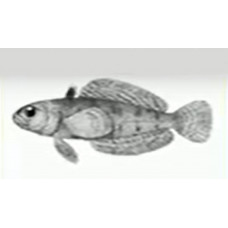Latin name
Pagothenia borchgrevinki
Other names
Bald rockcod, Pagothenia borchgrevinki
Identification
The first dorsal fin has 4-7 flexible barb rays, the second dorsal fin has 34-38 flexible rays; the anal fin has 30-35 flexible rays; the pectoral fin has 23-24 rays; the total number of stamens in the outer row of the first gill arch is 24-27, of which 16-19 in the lower part and 8 in the upper part. The dorsal lateral line has 43-52 scales, of which the first two are usually tubular, the rest punctate; the medial lateral line is short, with 8-10 punctate scales. Transverse scale rows on body 78-97. Total number of vertebrae 49-54, of which trunk vertebrae 18-20 and caudal vertebrae 31-34. Body completely covered with ctenoid scales, top of head bare. Body compressed laterally, not high, its height about 20-25% of the standard body length. Head slightly compressed dorsoventrally, small, about 24-29% of standard length. The length of the snout is about equal to or slightly longer than the diameter of the eye socket. The mouth is almost terminal, the lower jaw slightly protruding forward, small, with a slanting slit. The upper jaw is elongated. Teeth small, bristly. The eye is small, 23-29% of the length of the head. The interorbital space is fairly wide - 25-33% of head length. Pectoral fins slightly longer than ventral fins. Caudal fin slightly rounded. The overall colouration of the body in the live fish is yellowish, with a dark back and top of the head. The sides of the body have dark spots or narrow oblique stripes. Dorsal fins with a series of dark spots. Caudal fin without transverse dark stripes.
Distribution
Widespread circumpolar in the Antarctic marginal seas - Weddell, Lazarev, Riiser-Larsen, Cosmonauts, Commonwealth, Davis, Mawson, Durville, Somov, Ross, off both coasts of the Antarctic Peninsula, and also off the South Shetland and South Orkney Islands. It occurs mainly in association with land-fast ice on the shelf near the coast, and sometimes above deep water (up to 430 m) in clusters of Antarctic krill (Euphausia superba) in the upper pelagic layer from the surface to 72 m depth. It is more commonly found in the surface horizon at 20-50 m.
Habitat
A cryopelagic species permanently associated with the underside of landfast ice in the neritic zone. Fish use the ice for protection from predators and to feed on small crustaceans - copepods, amphipods and small euphausiids - which hide in ice cavities and cracks. A pelagic species, it lives in the cold waters beneath the ice at depths of up to 550 metres. Their blood contains special substances that prevent their plasma from freezing in icy water.
Size
Medium-sized fish not exceeding 28 cm in total length and weighing 250 grams.
Life history and Behavior
No information
Food and feeding habits
Fish use the ice for shelter from predators and for feeding, hiding in ice caves and cracks and feeding on small crustaceans - copepods, amphipods and small euphausiids.
Reproduction
Mature individuals of this species spawn once a year. The larvae have a long pelagic phase.
| Classification | |
| Phylum | Chordata |
| Class | Actinopterygii |
| Squad | Perciformes |
| Family | Nototheniidae |
| Genus | Pagothenia |
| Species | P. borchgrevinki |
| Features | |
| Conservation status | No information |
| Habitat | Pelagic |
| Life span, years | No information |
| Maximum body weight, kg | 0,25 |
| Maximum length, cm | 25 |
| Sailing speed, m/s | No information |
| Threat to people | Edible |
| Way of eating | Not predator |
Bald notothen
Tags: bald notothen

